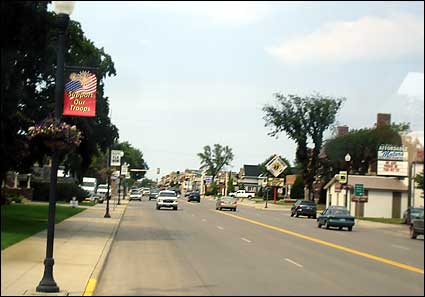Thought you all might like to read it too! Enjoy! Sarah :)
"Agriculture is the backbone of our economy, making up almost
25 percent of our state’s economic base (Source: ND Department of Agriculture).
To
reinforce this fact, I recently compiled a list of local businesses our farm
and our family patronized in one year- there were FIFTY! There were the obvious- our local implement
dealers, tire repair service, seed, fuel, fertilizer and crop protection
product suppliers, but many more were on Main Street and in Downtown Jamestown-
our bank, grocer, office supply store, dry cleaning service, restaurants, gift
shops, etc.
 |
| Main Street, Jamestown, North Dakota (Source: ScenicDakotas.com) |
Along with having such a positive economic impact, the
values that have carried farms and ranches through the generations are the
heart of our community. Every day
farmers and ranchers are working hard to provide safe, wholesome, consistent,
affordable products, in an environmentally conscience manner, for all of us to
enjoy.
 |
| Harvesting soybeans with a combine. |
With some help from Stutsman County Extension Agent, Lance
Brower, I discovered that according to the National Ag Statistics Service and
US Census, there are 1,043 farmers in Stutsman County. According to the American Farm Bureau
Federation, back in 1940, each farmer fed just 19 people. Today, the average American farm consists of
446 acres and each farmer feeds 154 people.
However, Mr. Brower and I found that in Stutsman County, our average
farm is 1,144 acres and each of our local farmers feeds 398 people!
 |
| Jeremy Wilson. One of 1,043 farmers in Stutsman County, each feeding 398 people each year! |
While farmers and ranchers have increased our overall
productivity, we have significantly increased our efficiency as well. For example, Dr. Jude Capper, Washington State
animal scientist, writes “Modern
dairy practices require considerably fewer resources than dairying in 1944 with
21% of animals, 23% of feedstuffs, 35% of the water, and only 10% of the land
required to produce the same 1 billion kg of milk. Waste outputs were similarly
reduced, with modern dairy systems producing 24% of the manure… The carbon
footprint per billion kilograms of milk produced in 2007 was 37% of equivalent
milk production in 1944.” Thanks to
technology, the same trend of making more with less is happening in every
sector of agriculture.
 |
| Dumping soybeans from the combines into the semi. |
Jeremy and I farm
because we want to have successful business that will provide for our family
for generations to come and we certainly love the work that we do, but at the
end of the day, we farm because God has called us to help feed His people. Truly, we do it for you."
Jeremy and Sarah Wilson own and operate J.S. Wilson Farm in Jamestown,
North Dakota. They have three children
who are the fifth generation on the Wilson Farm. They are the winners of the
2011 Stutsman County Soil Conservation Achievement Award. Sarah is also a professional speaker and
blogger at http://farmeronamission.blogspot.com


Love it!
ReplyDeleteTHANKS Janice!
ReplyDelete